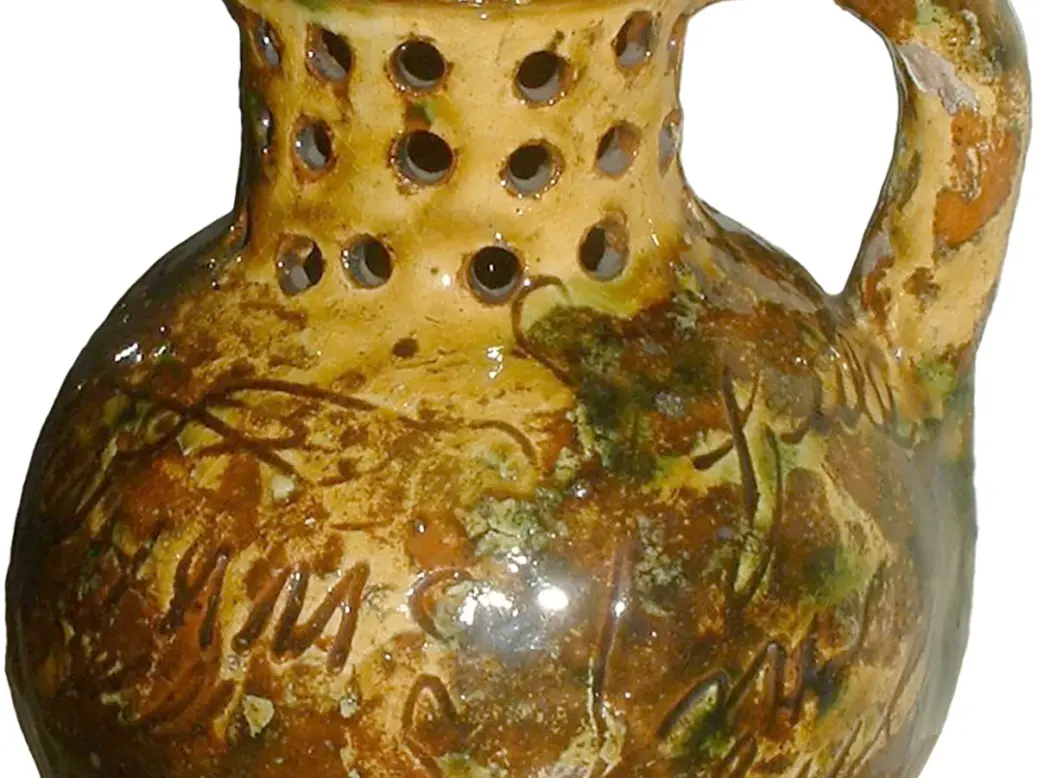
From pre-Columbian Peruvian lota vessels to the Exeter puzzle jug, Stuart Walton looks back at the ingenious ways in which trick vessels have been used to tease, confuse, and confound wine drinkers throughout history.
Ever since that business in Cana, when a wedding host who had inadvertently underprovided his daughter’s nuptials with a sufficiency of wine was rescued from social death by an itinerant prophet, wine has lent itself to miraculous and magical transformations.
Fermentation itself is something of a miracle. What starts out as sweet thick fruit juice becomes something not merely intoxicating, but full of sapid complexity, its many facets equipping it—the best of it, anyway—for further development with keeping. At the abracadabra moment when the 20-year-old bottle is opened, its origin as pressed must has vanished to sensual memory.
Its own innate biochemical magic has, throughout history, tempted out further ingenuities in the pouring and serving of wine. A lota vessel (an Anglo-Indian coinage from a Hindi word for a spheroid drinking vessel) dating back to the pre-Columbian Peru of the 13th century illustrates the cultural continuity of sustaining illusions. Standing about 12cm (4.7 inches) in height and measuring 16cm (6.3 inches) in diameter, it is a double-walled bowl of red clay that would enable the apparently inexhaustible pouring of a ritual libation from an empty vessel.
Similar technologies are known to have been in use in Classical Greek times. The vessel has an opening in the base, so that when it is filled with wine or water, the liquid escapes into the concealed chamber within its walls. A small vent at the top allows for the runoff to be trapped inside when it is covered with a thumb or fingertip, the same principle by which a column of your Manhattan can be trapped inside the straw if you cover the top end. A master of ceremonies would be able to pour out the wine in the cup, apparently emptying it, perhaps inverting it to prove the point. But then, on surreptitiously uncovering the top of the secret vent, he would allow the central bowl to fill up again, as though the wine were being miraculously renewed.
There are sizeable amphorae in museum collections in Amsterdam and Boston, Massachusetts, that appear to have had the capacity to repeat the replenishment trick up to ten times, albeit with a reduced quantity of wine each time. Some vessels contained separate chambers, so that both wine and water could be poured out from them alternately. The onlooker’s credulity would supply the all-important layer of wonder to the accomplished prestidigitator’s trick.
Trick vessels, dribbles, and practical jokes
Where trick vessels were not used for the higher purposes of religious ritual, they made reliably hilarious practical jokes. The dribble glass, a drinking vessel perforated with concealed holes in its design, ensures that at least some of the Malbec in it will end up splashing over your white shirt. Always warmly appreciated. Another ancient Athenian vessel in a collection in Toronto has a secret chamber in the foot, the wine in which would be held in when the server covered the vent. On tilting the cup to take a drink, the unsuspecting guest would then obligingly sprinkle himself with it.
The Exeter puzzle jug in the Museum of Somerset in western England works to roughly the same principle as the lota. Dating from around 1300, its neck is punctured with holes, raising the challenge of how to drink from it without wasting the wine. The solution was to suck it through the spout, as through a straw, by covering a vent on the inside of the handle. Its implicit challenge to the drinker was “How much do you want to drink?” Where there is the will, ingenuity should supply the way.
As with all tricks, it is best not to presume too much on the sense of humor of those one intends to dupe. The Georgian audience that packed the Haymarket Theatre in London in January, 1749, agog for novelty in an age of curiosities, had been promised a performance in which a man billed as the Bottle Conjuror would, in full view, insert himself into a quart wine bottle. “[T]his bottle is placed on a table in the middle of the stage,” claimed the press advertisement, “and he (without any equivocation) goes into it in sight of all the spectators, and sings in it.” Of course he does.
Nothing happened. Nobody appeared on the stage other than a theatre employee who feebly suggested there would be refunds if the performance failed to go ahead. There was no music to keep the restive spectators placated. As it sank in that the Bottle Conjuror was a figment of somebody’s entrepreneurial imagination, the crowd grew fractious to the extent of demolishing the fittings, dragging benches out on the street and setting them ablaze. Their fury is telling. It’s one thing to spray yourself unwittingly with wine from a dribble glass, quite another to be hoodwinked into believing that a man could squeeze himself into a bottle.






